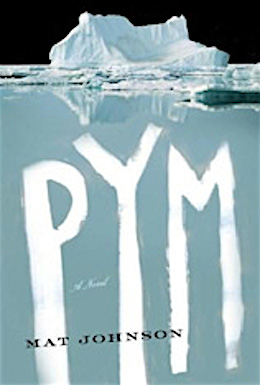Like many of my favorite books, Pym goes from an innocuous to ridiculous to horrifying very abruptly. For about the first 150 pages, I’d be comfortable saying that Pym was one of the funniest books I’ve ever read. Then it abruptly turns into a particular type of horror story. It does get funny again, but I don’t want to spoil it for any of you who may want to read it, so I’m going to dance around a bit and talk about the opening.
Pym is an intricately-plotted response to Edgar Allan Poe’s The Narrative of Arthur Gordon Pym. The original Pym follows the titular character as he survives bad seas and mutinies to sail down toward the South Pole. He comes upon a land called Tsalal, an island inhabited by natives who are so “black” they even blacken their teeth. (Much of the Tsalal section is about Pym’s horror of blackness.) After the natives betray them, the group flees to Antarctica along with one kidnapped Tsalalian. Pym’s story ends as they encounter a giant shrouded white figure, and the book ends with a postscript explaining Pym’s death. Mat Johnson’s Pym presupposes this story is rooted in historical fact, and takes off from there with a wide-ranging tale that travels from New York to Gary, Indiana to Antarctica.
The book begins as a campus comedy. Chris has just been refused tenure at a liberal arts college in the Hudson River Valley, which will cut short his efforts to study the origin of the idea of whiteness. He’s particularly interested in The Narrative of Arthur Gordon Pym by Edgar Allan Poe, and Antarctican adventure yarn that is Poe’s only novel. The book cuts off abruptly with descriptions of shambling white horrors in the ice, and Chris thinks that this marks a moment in Western history when the idea of pure whiteness took root in the American imagination.
Unfortunately, his tenure committee is pissed that, as the only Black faculty member, he’s unwilling to head up their suspiciously pale diversity committee. But no matter! He finds clues that seem to indicate that Pym is a true story, scrounges up funding, and sets sail for the South Pole himself, determined to write an opus on the Heart of Whiteness.
It shifts gears a few times from adventure to horror, but remains hilarious. The cast of characters is outstanding, including Chris himself, whose inner monologue walks a knife-edge between self-awareness and utter delusion, his childhood friend Garth, devotee of Little Debbie snack cakes and a saccharine painter named Thomas Karvel, Chris’ cousin Booker Jaynes, a sea captain forever on the watch for conspiracy, Jeffree and Carlton Damon Carter, a couple who long for adventures to film to get their YouTube channel better numbers, and finally Chris’ ex, Angela, and her new husband Nathaniel. If you’re suspecting that Chris isn’t quite over Angela, and wasn’t planning on Nathaniel coming to Antarctica with them, you’re correct.
The book ranges across half of the southernmost continent, looking for proof of Pym, proof of the beasts Captain Jaynes refers to as “snow honkies”, and proof that “Painter of Light” Thomas Karvel has a bunker somewhere under the ice (Because yes, Johnson has included a spot-on, fantastic parody of Thomas Kinkaide here) all in a hunt for Tsalal. And if at first this seems like too many threads and obsessions, Johnson makes them all dance around the central conflict between the concept of whiteness and its constant subjugation of blackness. For instance, on those Karvel paintings:
I grew up with Garth, in the same neighborhood for ten years. This stuff didn’t look like out home. There were no black people in any of Karvel’s paintings, not one in all the ones that engulfed the room. Actually, that is not a fair assessment, there are no blacks in the paintings of Vermeer either, but I didn’t get the same feeling from his work—and Vermeer was Dutch, the old scary Dutch West Indian kind of Dutch, too, not the modern, happy-go-liberal version. It wasn’t just that there were no black people present, it was also that Karvel’s world seemed a place where black people couldn’t exist, so thorough was its European romanticization. With its overwhelming quaintness, its thatched roofs and oversaturated flowerings, this was a world that had more to do with the fevered Caucasian dreams of Tolkien and Disney than with any European reality.”
I should note that as a white woman there are some things in this book I am not qualified to comment on. OK, a lot of things. But I can say that it’s hilarious, especially if you’re one of those rare white people who’s willing to laugh at yourself. (I mostly am.) Just to give you a taste, there’s a man named Booker who keeps a Dalmatian named White Folks mostly so he can yell angrily about, well, the actions of White Folks. White Folks the dog doesn’t seem to mind, though, just cuddles everyone in his immediate proximity. This book also contains this sentence: “In 6th grade an effete little frog named James Baldwin whupped my ass.” That would be the narrator, Chris Jaynes, speaking, and the James Baldwin he’s referring to is an elementary school kid, not the esteemed author of The Fire Next Time. This sense of play with Black literature and history, and white culture’s raiding of the literature and history, make for some of the best bits of the novel.
Pym is hilarious, and by the end actually becomes the multi-layered commentary on “whiteness” and “blackness” that its narrator traveled across the globe to write. I’ve read several books lately that have taken on hoary classics and dragged them into the modern era, but I think Pym might be the most fun.
Leah Schnelbach knows that as soon as this TBR Stack is defeated, another will rise in its place. Come give her reading suggestions on Twitter!










